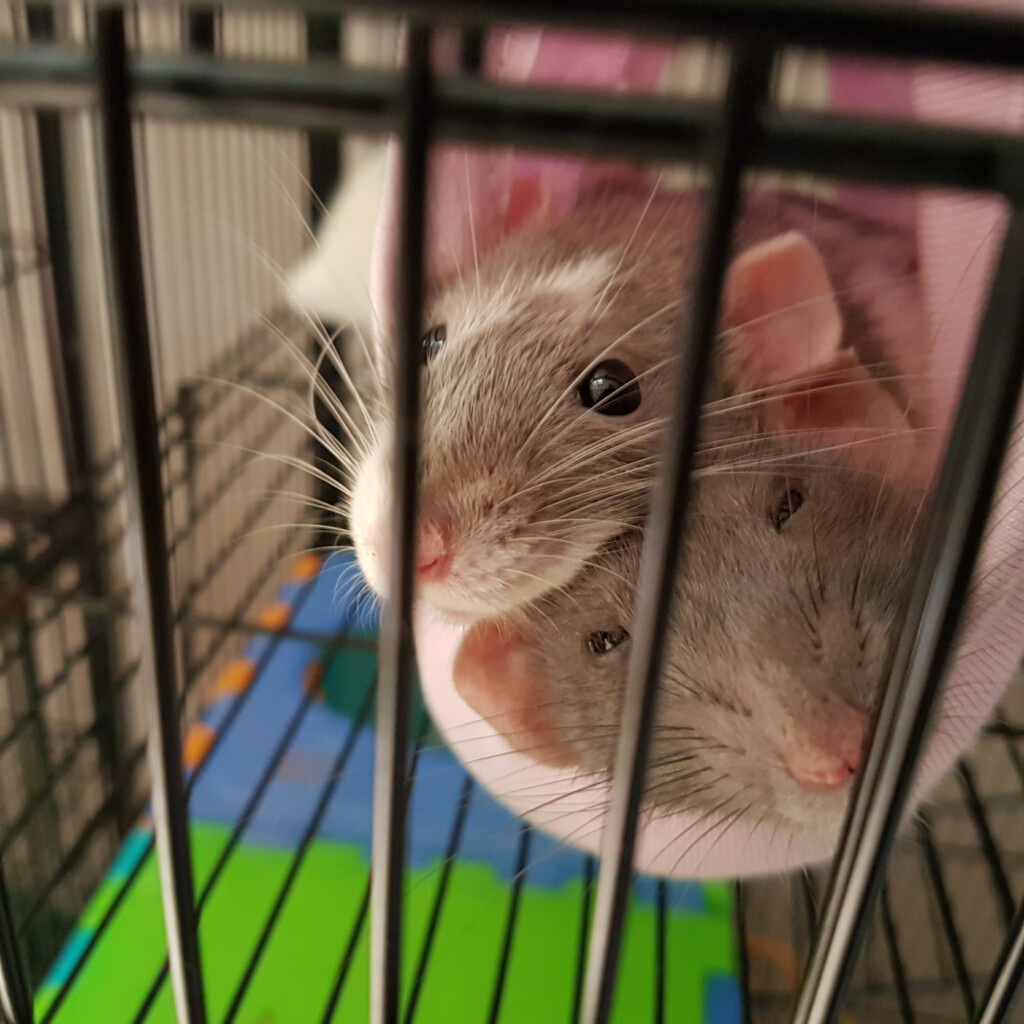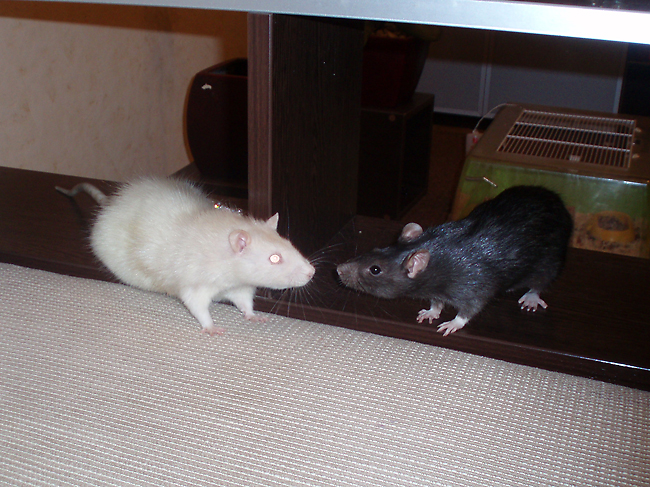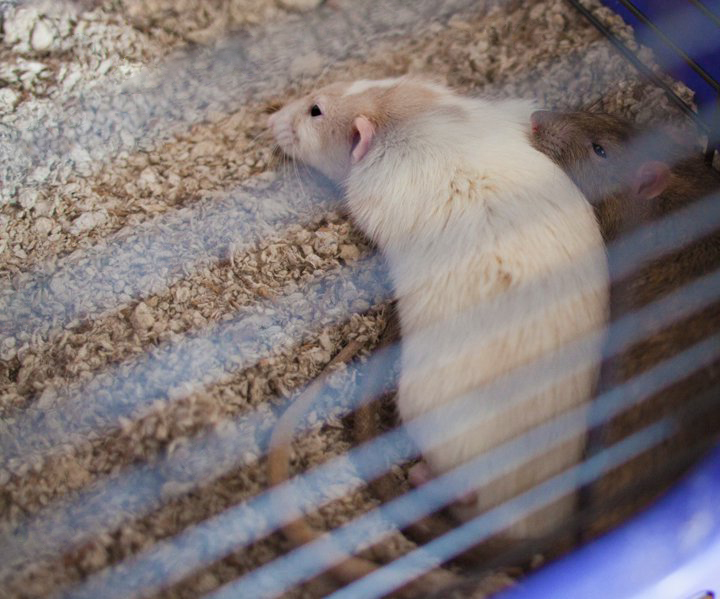I’m sure you already know that rats thrive in pairs or groups! But what happens if your rats haven’t known each other since birth? Or if you only have one rat left and want another to keep them company?
Fortunately it’s possible to introduce two unfamiliar rats to each other! It just takes some time, patience, and understanding of how different rats might respond to each other.
All introductions should be handled with care. Rats are highly social animals, but can be territorial and aggressive towards a new rat. As long as you take things step by step, you can have them happily snuggling with each other in no time.
If you plan to add a new rat, you will need a second cage for the first couple of weeks while your rats get to know each other. It doesn’t need to be a full sized cage, especially if your new rats are still babies.
How long does it take to introduce new rats to each other?
It depends on the personality of your rats. Some rats take to each other right away with no issues while others need time to work things out. You can expect some minor scuffles, but it’s important to know when to draw the line and separate your rats.
You can expect at least a week, but 3-4 weeks of introductions is sometimes needed before unfamiliar rats can happily live together.
If you have a whole group of rats, it can take longer for them to establish their social order and settle in together. Rats have amazingly complex social dynamics and it’s fascinating to watch as they unfold!
Even if they seem like they’re getting along well outside of the cage, make sure to follow the process step-by-step. Things can quickly change.

How to introduce two rats (step by step)
Follow the steps below. If you notice signs of aggression (below) at any point, it’s best to end the session for the day. You can always try again the next day once your rats settle down. If you’re introducing multiple rats, see below.
- Quarantine your new rat(s) for 2 – 3 weeks in a separate room. Make sure to wash your hands in between handling your new and old rats, to prevent any diseases from spreading between them. Watch out for any signs of illness during this time – particularly respiratory illness. It’s a good idea to spend this time bonding with your new rats, so that they trust you by the time you start introductions with your other rats.
- Keep the two cages in separate rooms if possible. You might have heard that you should keep the two cages side by side for awhile so that your rats can sniff each other through the bars. Personally, I find this just increases the tension between them before your rats even get the chance to meet each other. I like to keep the cages separate until they can get along in neutral territory.
- Introduce your rats somewhere neutral to both of them. This could be the bathroom, or any room that your rats don’t play in often. The idea behind a neutral space is that your current rats haven’t marked it as their territory, so they shouldn’t feel the need to defend it. A small space without any distractions or places for them to run and hide under is best. The bathtub or shower is perfect for this!
- Plan for about 5-10 minutes for a first introduction, so they can sniff each other a little and go home with a great impression!
- Expect your rats to be very interested in each other. They may follow each other around and sniff each other a lot. Pay attention to any signs of stress or aggression, like puffed out fur or huffing noises. Stay close by and keep a towel ready to grab them with, especially if they start chasing each other.
- Each day, let your rats interact with each other outside of their cages a little longer and with a little more freedom. Pay close attention to make sure things are going well.
- You can usually expect some little scuffles as the rats figure out their hierarchy. Some rats are more dramatic about this than others. Use your best judgment to determine whether these fights are truly aggressive, or if they seem to resolve.
- Praise and encourage your rats when they stay calm in each others’ presence, or doing social things like grooming each other and snuggling. Give them both lots of pets and attention.
- If your rats are able to play together outside of their cage without any major fighting, you can pick a day when you have several hours free to monitor them inside the main cage together. First give the cage a good cleaning. You might want to minimize the number of toys and accessories inside the cage for the first little while, so you can get a clear view of what everyone’s doing.
- If your rats happily accept the newcomer in their cage, congratulations! Continue to keep an eye on them over the next few weeks, just to make sure nobody is getting bullied. Keep monitoring for signs of stress like puffed out fur or porphyrin (which can also be caused by other things, like illness.) Watch out particularly for bites – rats shouldn’t normally bite each other hard enough to leave a wound.
In the next sections, we will cover signs of stress, aggression, and what to do if your introductions aren’t going as smoothly as you hoped.
How can you tell if your rats are getting along?
While you’re introducing rats, you want to see signs like these:
- They appear to be very interested in each other, but relaxed
- Minimal signs of stress (i.e puffed out fur)
- Sniffing each other a lot
- Grooming themselves and each other
- Sleeping and eating around each other
- Snuggling, licking
- Play fighting (see below)
These are all signs that your rats feel safe and relaxed in each others’ company.
Ignoring each other is not necessarily a bad thing. It shows that neither of them wants to fight. The only thing you really don’t want is bad fights where they try to injure each other.
Are your rats playing or fighting?
If you’ve ever watched two rats playing, you’ll know they love to rough house with each other. (Shadow the Rat has a great video!)
While their play fights can be fast and look a bit furious, you’ll probably notice a difference in the intensity between social wrestling and true aggression.
You can expect lots of scuffles while they figure out their new social structure. This can be an ongoing thing, even with rats who like each other. The important thing is that they don’t turn into true fights.
These things are normal and to be expected:
- Occasional squeaking
- Pinning each other to the ground and grooming each other
- Staring at each other
- Standing up on two legs and pawing at each other
- Swinging their bums at each other
It’s normal for things to be tense for awhile. Just keep a close eye on them as they sort it out.

Signs of aggression between two rats
These are some signs that you need to separate two unfamiliar rats and possibly go back a step:
- Biting each other
- Drawing blood
- Tearing out fur
- Hissing or “huffing” noises
- Charging at each other sideways
- Severe fighting – you will definitely notice the difference in speed and intensity! A severe fight is sometimes called a “rat ball”.
- Puffed up, spiky fur – shows that they are stressed with each others’ presence.
It’s important to take a break if you see your rats getting very stressed out and aggressive with each other.
Try not to let an aggressive rat chase the other, as this can cause more serious injuries. When a rat is trying to chase another rat away, they will usually try to bite them towards the bum. Definitely a bad sign!
If you need to, you can use a thick towel to grab one or both of your rats to keep them from hurting each other.
What are the best ages to introduce rats?
It can be easier or more difficult to introduce rats, depending on their relative ages.
Introducing multiple young rats
Rats under 6 months old are the easiest to introduce to each other. They don’t tend to display the same hormonal aggression or territorial instincts that older rats have, and accept each other a little more readily.
Introducing babies to adults
Most rats are ready to be introduced to adults around 8 weeks (2 months) old. If your babies are super small compared to the larger rats, you might want to wait a bit longer.
Young rats are usually more easily accepted than other adults because they don’t pose as much of a threat to the existing group. But with that said, you’ll still need to be cautious if your older rats show any aggression towards them because of the size difference.
Believe it or not, even older male rats tend to be fairly accepting towards young males (around 8 – 12 weeks old).
While you might assume that female rats would easily accept babies, this isn’t always the case. It’s still just as important to follow the introduction process with two or more unfamiliar females.
Introducing adult rats
You can introduce two or more adult rats, though it’s sometimes more challenging than with babies. Especially with males, once they reach the age of 6-7 months they tend to be more hormonal and aggressive towards intruders.
With that said, it’s definitely not impossible to introduce older rats. It might just be more challenging to decide whether they’re getting along or not as they establish a hierarchy with each other.
It’s normal for both male and female rats to “spar” with each other quite a lot. You’ll still have to watch out for serious aggression towards each other and make sure that their scuffling doesn’t turn into injuries or ongoing stress. (See the sections below on play fighting and signs of aggression.)
Depending on the level of aggression towards other rats, some males may need to be neutered before they can happily settle into a group.
Should I introduce rats one at a time?
If you’re introducing multiple rats, it might be less chaotic for you to introduce them in pairs before bringing them together as a group. If you can get one of your calmer, more submissive rats to accept the new rat(s), that can help your more dominant rats accept the newcomers too.
Why do you need to introduce rats so slowly?
Rats are protective of themselves and their homes. They are capable of badly injuring and even killing new rats.
The worst thing you can do when introducing rats is to just toss a new rat into your existing cage! Rats see this as a threat and may fight, badly injure or even kill the new rat. It’s also extremely stressful for the “intruding” rat.
Throwing them in a cage together is like if a random person walked right through your front door without knocking. You probably wouldn’t like it either!
I’ve had rats for years and always thought of them as very sweet and gentle. So I found it hard to believe they would ever kill a newcomer. But sadly a friend of mine experienced this by skipping the introduction process. It only takes one serious bite, especially if one rat is smaller than the other.
The default behavior for rats is to attack any unfamiliar intruders in their space. That’s why it’s so important to introduce them slowly and make sure it’s going well before you let them live together.
Can you introduce any two rats?
Keep in mind that every rat is a little different, and they each have different personalities. It’s tough to predict which rats will be aggressive towards newcomers, because sometimes even the friendliest ones can be territorial at first.
I’ve had rats who adored each other right away and were absolutely inseparable. They spent most of their time grooming or sleeping on each other and you rarely found one without the other.
I’ve also had two males who were not the best of friends, but they never showed aggression towards each other. They more or less just left each other alone.
One had a very laid back disposition, while the other arrived at my house with a wound on his nose, possibly from another rat. He seemed to have an attitude of suspicion towards other rats his whole life.
The two didn’t appear to be stressed out in each others’ presence. So they happily lived together in a large cage, giving each other plenty of space. They would sometimes groom each other, but I only remember seeing them snuggle a few times.

Personally I think my grumpy boys were still grateful for each others’ company.
Rat introductions not going well?
Just because there’s a setback doesn’t mean your rats can never live together! Some rats are just less accepting of each other at first. While it can be stressful to watch your rats fight, sometimes they just need to get it out of the way early on.
Take it more slowly and even try going back a few steps in the process. A few extra days or weeks of introductions will be worth it.
If you’ve tried introducing males several times and it’s just not happening, neutering can really improve aggression and territorial problems.
As a last resort: keep them separated. Sometimes it’s just not meant to be. If you’ve tried your hardest to introduce two rats and they’re just not having it, it’s okay to let them be. Some rats may even tolerate each other outside of their cage, but not living together.
Conclusion
Did this article give you more confidence to introduce your rats? I wish you the best of luck and if you have any questions, just leave a comment 🙂






